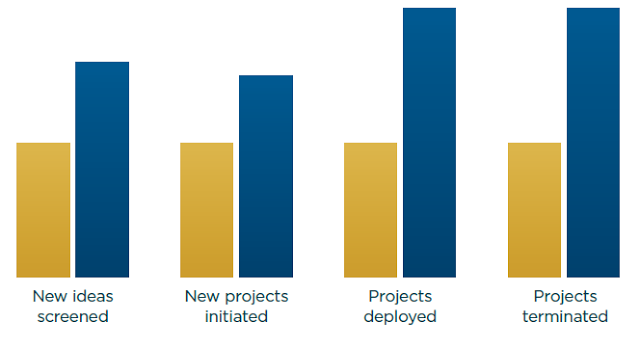By: Don Creswell, Co-founder & Vice President, SmartOrg Inc.
When it comes to portfolio management, it can be easy ' in
many cases, too easy ' to explore the theory side of the equation without
looking at hos companies in the real world are living the principles of value
creation. Let's take a look at how one of the largest petroleum companies
benefited from implementing them.
When it comes to portfolio management, it can be easy ' in
many cases, too easy ' to explore the theory side of the equation without
looking at hos companies in the real world are living the principles of value
creation. Let's take a look at how one of the largest petroleum companies
benefited from implementing them.
The managers of R&D/technology portfolios were pressured
by management to accelerate the deployment of technology to business
opportunities. The business needs for technology were not being met in a timely
fashion while at the same time corporate growth bottom-line objectives were
demanding more for less money. Projects were being kept alive too long, and
there was an inconsistency in how projects were evaluated. Senior managers were
having difficulty comparing projects of different types and the company was
experiencing significant limitations of a subjective 'thumbs-up/thumbs down'
approach to prioritization of projects in the development portfolio.
by management to accelerate the deployment of technology to business
opportunities. The business needs for technology were not being met in a timely
fashion while at the same time corporate growth bottom-line objectives were
demanding more for less money. Projects were being kept alive too long, and
there was an inconsistency in how projects were evaluated. Senior managers were
having difficulty comparing projects of different types and the company was
experiencing significant limitations of a subjective 'thumbs-up/thumbs down'
approach to prioritization of projects in the development portfolio.
The existing portfolio management process was primarily a
roll-up of business cases to justify projects, which as noted above, led to
inconsistent project evaluation, making it quite difficult to objectively
compare projects with the portfolio. The process was competitive and
adversarial, supported by little quality data.
A senior manager of a major technology portfolio decided to
meet the challenges by implementing SmartOrg's value-based management process,
supported by Portfolio Navigator' software. The new process made project
evaluations transparent to all team members, clearly identifying key value
drivers and addressing the impact of uncertainty on the NPV of each project.
'
A peer and expert review process emphasized
transparency, creditability and comparability.
A peer and expert review process emphasized
transparency, creditability and comparability.
'
Uncertainty tracking included baseline
assessments of the ranges of uncertainty around each factor in the model.
Updates were based on evidence and learning as projects moved through
development.
Uncertainty tracking included baseline
assessments of the ranges of uncertainty around each factor in the model.
Updates were based on evidence and learning as projects moved through
development.
'
The transparent process helped address 'garbage
in, garbage out' concerns, which had historically been one of the most
challenging issues.
The transparent process helped address 'garbage
in, garbage out' concerns, which had historically been one of the most
challenging issues.
Within one year following implementation of value-based
management, the portfolio manager reported a 60% increase in new ideas
screened; a 50% improvement in new project initiated and a 100% increase in
projects deployed and projects terminated. By stopping one project a year
earlier, funding and resources were made available to accelerate development of
more promising projects, adding $10 million in value to the portfolio ' 30% of
the annual budget.
management, the portfolio manager reported a 60% increase in new ideas
screened; a 50% improvement in new project initiated and a 100% increase in
projects deployed and projects terminated. By stopping one project a year
earlier, funding and resources were made available to accelerate development of
more promising projects, adding $10 million in value to the portfolio ' 30% of
the annual budget.
An additional benefit: credible, comparable evaluations
allow every member of the team to view the importance of his/her contribution
to creating value and to develop understanding and accept decisions that may
reject their pet projects when other projects can be shown to have higher value
potential for the organization.
allow every member of the team to view the importance of his/her contribution
to creating value and to develop understanding and accept decisions that may
reject their pet projects when other projects can be shown to have higher value
potential for the organization.
Key ' yellow: before Value-Based
Evaluation ' blue: after Value-Based Evaluation
Evaluation ' blue: after Value-Based Evaluation
This
is the fourth in a series of blogs on The Six Principles of Strategic Portfolio
Management. Subsequent blogs will address each of the six principles in detail.
For further information about SPM processes and decision-support software,
visit www.smartorg.com or contact info@smartorg.com
is the fourth in a series of blogs on The Six Principles of Strategic Portfolio
Management. Subsequent blogs will address each of the six principles in detail.
For further information about SPM processes and decision-support software,
visit www.smartorg.com or contact info@smartorg.com

